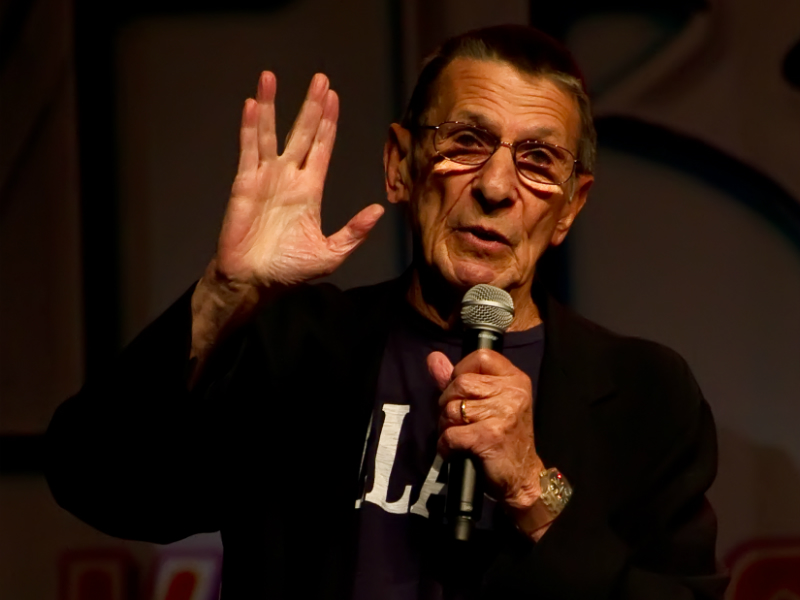“Live long and prosper.” These words, along with the Vulcan salute, are immediately recognized and associated with Star Trek, which is celebrating the 53rd anniversary of its first episode this month. Their origins do not emanate from the vast final frontier, however, but rather from Leonard Nimoy’s Jewish heritage.
With Star Trek, Gene Roddenberry’s mission was to tell stories that included elements from a diversity of cultures, be they alien or Earthly. So when Leonard Nimoy had an idea for a Vulcan greeting, Roddenberry let him bring along a piece of his culture.
Nimoy recounted the story of Star Trek’s Season 2 premiere, titled “Amok Time,” the first episode of the show where Spock visited the planet Vulcan (where he was to be married). It would be the first time another Vulcan would be seen on screen. After considering the greetings people have across cultures, Nimoy thought the Vulcans should have one of their own.
Though most of us immediately recognize the salute as the Vulcan greeting, its true origin comes directly from the Torah.
I met with Rabbi Howard Morrison of Beth Emeth Synagogue in Toronto, an expert on both Judaism and “nerd TV culture,” who told me more about the origin of the salute. “When the Kohanim do the priestly blessing, they take their two hands and bring the thumbs together and it’s like the ‘Live long and prosper’ sign,” he explained. But, Rabbi Morrison continued, the version in the blessing differs slightly: Spock “only does it on the show with the one hand,” he noted, “but the Kohanim, when they do the blessing, use two hands, and connect the thumbs to make the Hebrew letter shin (representing the first letter of one of God’s names).
The hand sign is done during the performance of the blessing by the Kohanim, who stand at the front of the sanctuary and bless the congregation. Historically, this was done daily in the Holy Temple, when it stood in Jerusalem. “You needed the Kohanim and their officiating to be able to fulfill certain Jewish practices,” Rabbi Morrison explained, adding, “Now, the blessing is done ‘symbolically’ by the Kohanim daily in Israel, and outside, during festivals.” (The words in the blessing itself are part of the daily prayers, but the sign we know as the Vulcan salute is only done when the Kohanim are called upon to stand before the congregation and recite them.
READ: SCHWARTZBERG: A TRIBUTE TO HARLAN ELLISON
Though Jewish fans of Star Trek might be thrilled by the revelation of something so deep in our culture, many of us have never seen the hand sign used in religious practice. Per Rabbi Morrison, “You’re not supposed to look when the Kohanim do the blessing and ‘salute,’ because you are supposed to be focusing on the words and thinking of God as opposed to focusing on the people saying the words.
“There are some who believe that if you look, you will go blind, but the idea is that the focus should be on hearing the words and internalizing the meaning of the words and not looking at the Kohanim who are doing it. But neither Nimoy or I could help ourselves – we peeked.” Indeed, the Spock actor recalled a time he attended synagogue and his father told him not to look when five or six men stepped to the bimah and began shouting a blessing. He knew something “major” was happening, so he snuck a view of those men with their hands poking out from their tallitot in a striking hand sign that he thought was “magical.” Years later, Nimoy would suggest this magical hand sign extend from his personal heritage to that of his character.
Though Nimoy could flash the sign with ease, not every Vulcan could. Celia Lovsky, who played T’Pau, the Vulcan minister, was unable to do the sign on her own and had her fingers taped together for production. Zachary Quinto allegedly had some trouble with the salute and did some Vulcan finger exercises while preparing for his most logical role. It was said his fingers were glued together for production, but Quinto swears this is just a rumour. Though I can’t say for sure, I have a suspicion that Arlene Martel, who played Spock’s bride-to-be, T’Pring, a fellow eastern European Jew, could probably flash the sign with ease.
This story was originally published by StarTrek.com and CBS. It has been reprinted with permission.
